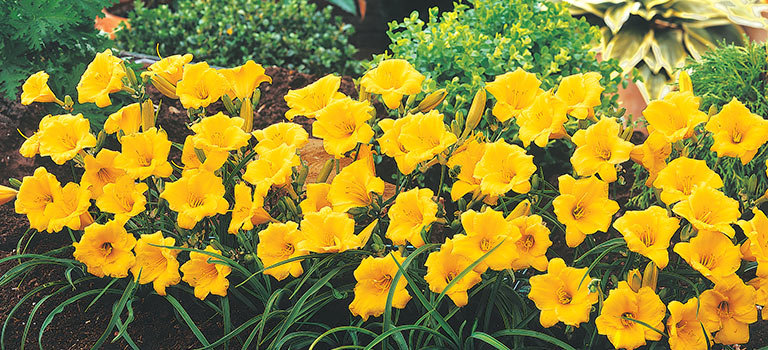What Are Daylilies?
Daylilies, or hemerocallis, are not true lilies. Instead of growing from a rhizomatous bulb, daylilies are perennials with a root system that branches out underground. Most daylilies have six sepals, and most have six colorful stamens in the center of the flower. Their strap-shaped green leaves set daylilies well apart from true lilies, due to their full and long-lasting foliage.
The daylily’s botanical name, hemerocallis, literally translates into “beauty for a day.” The flowers of most daylilies do, indeed, last for a single day, but these vigorous bloomers grow at flowers on each scape or stem. Their long blooming season, easy care, and disease resistance, along with a wonderful trait for filling in sparse areas of the garden, make sun-friendly daylilies a favorite choice in landscaping! These popular perennials have been hybridized to bloom in nearly every shade and color imaginable, with doubled, ruffled, and variegated varieties galore. You’ll also find dwarf daylilies, tall daylilies, and everything in between, so you can find a perfect plant to suit your space and needs.
When do daylilies bloom? Most daylilies bloom in June or July, but mixing early, mid, and late flowering varieties can extend the show of blooms from May through September. Some types have two blooming seasons, one in spring and one in late fall. No matter what you’re looking for, we’re sure there’s a daylily for you to love!
Planting Daylilies
There are two ways to propagate daylilies: as bare roots and from seed. Our daylilies are sold as bare root perennials, which gives them the best chance of success for the growing season. While it is possible to plant daylilies from seed, this path is typically taken for hybridizers wishing to create new varieties of daylilies. Daylilies grown from seed take two to three years to produce flowers, while daylilies propagated from split roots will begin flowering in the same year they’re planted.
Daylily bare roots should be planted in spring, to allow them to build a root system before the harsh winter months. In general, you should plant bare root daylilies when the weather has warmed, but the ground is still cool but not frozen. In warmer climates, planting will be in very early spring. In temperate and cooler climates, wait until April to plant. Breck’s will ship your daylilies when they’re ready to plant!
A great location is key to the success of your perennials—luckily, daylilies are incredibly easy to place. These plants prefer at least six hours of sun each day, and they require well-drained soil to avoid root rot. As you decide where to plant, mix and match your daylilies to create the perfect look! Use tall varieties as statement pieces in the garden, or fill in under trees and in borders with dwarf daylilies. Consider daylily bloom time, too. By pairing varieties with earlier and later bloom times, you’ll ensure that there are no “blank” spots in your landscape throughout the bloom season.
Once you’ve chosen your location, planting daylilies is fairly simple. Loosen the soil using a hoe, shovel, or claw tool, and mix in compost for drainage and nutrients. Soak your daylily bare roots in clean water for an hour or two before planting. Then, plant the daylilies so that the crown—where the leaves meet the top of the roots—is at ground level. Water the plants in well, and get ready to enjoy a season of gorgeous flowers.
How To Care For Daylilies
Daylilies don’t need require too much care through the growing season, but you should water them weekly if the weather becomes dry. In late spring, add an extended release fertilizer to your watering routine to help encourage reblooming, especially if you are growing a reblooming variety.
One great characteristic of hemerocallis is their ability to retain attractive foliage after the blooming season, so you won’t need to worry about trimming back leaves until the fall. When the weather cools, trim your daylilies to about two inches above the ground. Daylilies are quite winter-hardy, so you won’t need to lift these beauties, or spend much effort overwintering. However, a thin layer of mulch can help your daylilies stay insulated over winter, and get ready for next spring.
When and How to Divide Daylilies
Dividing daylilies—propagation by root division—keeps your daylilies happy and uncrowded. Most daylily plants need to be divided every three to five years. To divide daylilies, you’ll need to dig up the plants, divide them into sections, and replant them. You can spread your daylilies out, plant the divided starts in a new location, or give them away.
When should you divide daylilies? You’ll need to give the plants a few years between divisions to create new roots. Daylilies are best divided every three to five years, but can be divided after two years in the ground. The best time to divide daylilies is either early spring, before the plants have begun to grow, or late fall, after the blooming season.
Dividing daylilies is pretty straightforward. You’ll need a shovel or spade, and a sharp dividing tool or pair of scissors. To divide daylilies, do the following:
- Dig up your daylily plants, along with its entire root system.
- Gently shake or brush the dirt from the roots.
- Separate the roots into the two or more distinct groups. Each group should have at least three stems, and a healthy amount or roots.
- Cut the roots apart, and discard any roots that are damaged or diseased.
- Replant your daylilies. Set the crown at ground level, and use the opportunity to mix in fresh compost to your growing site.
And that’s it! Your “new” daylilies should grow just as the original sets did, and provide even more color to your landscape.



